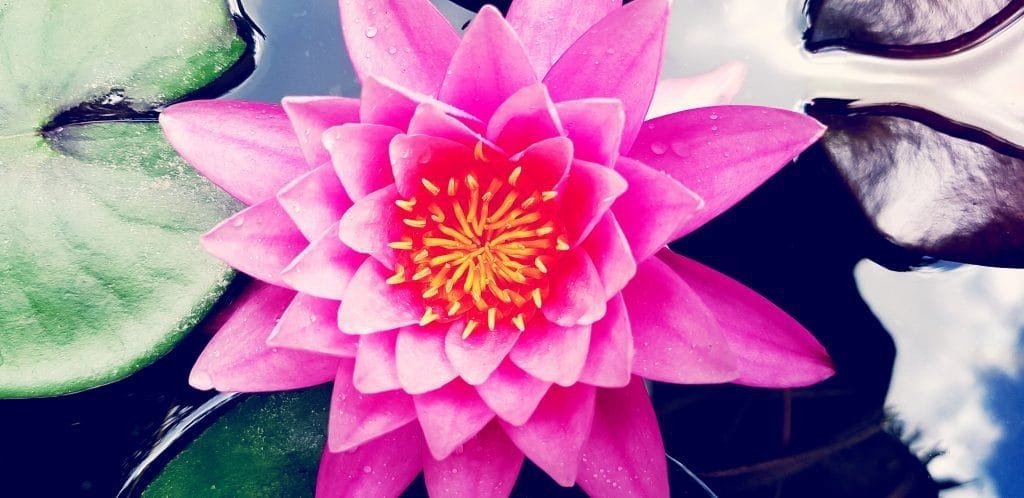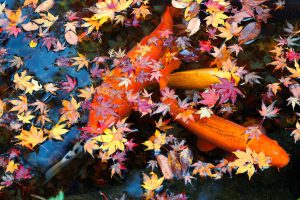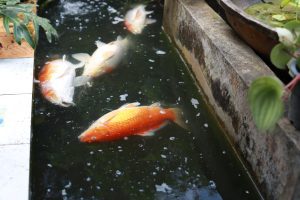
Deep Water Pond Plants: Essential Tips for Thriving Aquatic Gardens
Deep water pond plants are essential for creating a balanced and beautiful aquatic environment.
These plants not only add visual appeal but also help maintain clear water by providing shade and removing excess nutrients.
Choosing the right deep water plants can transform a simple pond into a thriving ecosystem that supports various wildlife.

With options ranging from stunning water lilies to unique varieties like water hawthorn, there is a plant suitable for every pond’s depth and conditions.
Understanding the specific needs and roles of these plants is crucial for gardeners looking to enhance their outdoor spaces.
Proper installation and ongoing care will ensure that these plants flourish throughout the seasons.
Key Takeaways
- Deep water plants enhance pond aesthetics and ecological balance.
- Selecting the right species is vital for successful growth and maintenance.
- Careful installation leads to a thriving aquatic environment.
Types of Deep Water Pond Plants
Deep water pond plants thrive in the cooler and darker depths of a pond.
They play a crucial role in maintaining a balanced ecosystem. The main types include water lilies, submerged pond plants, and floating leaf plants, each with unique characteristics and benefits.
Water Lilies
Water lilies, especially from the genus Nymphaea, are popular for their beauty.
They grow in deeper water, often at depths of 30 to 120 cm. Their large, floating leaves create a stunning surface display while providing shade to aquatic life beneath.
These plants bloom with vibrant flowers that can be white, yellow, or pink, attracting pollinators like bees.
Water lilies also help reduce algae growth by blocking sunlight from reaching the water, promoting a healthier pond environment.
Their roots anchor in the pond’s bottom, allowing them to thrive in stable, nutrient-rich soil.
Submerged Pond Plants
Submerged pond plants grow entirely underwater and are vital for aquatic ecosystems. These plants include species like Elodea and Myriophyllum.
They absorb nutrients directly from the water, helping to purify it and reduce excess nitrates.
These plants provide shelter for fish and other aquatic organisms while serving as a food source for some species.
Their presence helps promote oxygenation in the water, which is essential for the overall health of the pond.
Submerged plants also stabilise sediment, preventing erosion and providing a habitat for microorganisms.
Floating Leaf Plants
Floating leaf plants, such as the water hawthorn, have leaves that float on the surface while their roots dangle in the water.
These plants add aesthetic value with their unique leaf shapes and can spread rapidly, covering large areas.
These plants help filter pollutants and improve water quality by absorbing harmful substances.
They also create hiding spots for fish and other aquatic life. By providing shade, floating leaf plants contribute to temperature regulation in the pond, which is crucial for the wellbeing of its inhabitants.
Essential Equipment for Planting

Planting deep water pond plants requires specific equipment to ensure proper growth and health. The right tools make a significant difference in how well plants establish themselves in the pond environment.
Planting Baskets
Planting baskets are essential for deep water plants. These baskets allow the roots to stay anchored while permitting water and nutrients to flow in easily.
Typically, they come in various sizes. Common options include:
- 1-litre baskets for smaller plants
- 3-litre baskets for larger varieties
These baskets prevent soil from escaping while still providing ample space for root expansion.
When choosing a planting basket, consider the material. Strong, durable materials such as plastic ensure longevity.
Some baskets also have perforations to enhance drainage and aeration, which is crucial for healthy roots.
Aquatic Soil
Aquatic soil is another vital component for planting deep water plants. Unlike regular garden soil, aquatic soil is specially designed to retain moisture and provide necessary nutrients.
This type of soil is typically rich in organic matter. It’s essential for supporting the growth of pond plants.
The soil should be heavy enough to stay in the basket but not so dense that it suffocates the roots.
When preparing to plant, fill the basket halfway with aquatic soil. Then, add the plant and cover the roots gently with more soil.
This method helps maintain the plant’s position, allowing it to thrive in deeper water conditions.
The Role of Aquatic Plants in the Ecosystem
Aquatic plants play vital roles in maintaining a healthy pond ecosystem. They contribute to oxygenation and provide essential habitats for fish and wildlife. Their presence supports biological balance, making them crucial for sustaining pond life.
Oxygenation
Oxygenators are key components in any aquatic system. These plants, such as water lilies and hornwort, perform photosynthesis, which produces oxygen that dissolves in the water.
This oxygen is vital for fish and other aquatic organisms to thrive.
As oxygen levels fluctuate, healthy oxygenators regulate the environment.
During the day, they release oxygen, balancing the carbon dioxide produced by fish and decomposing organic matter. This ensures aquatic life has the necessary oxygen to survive, especially in deeper waters where oxygen levels can be low.
Fish and Wildlife Habitat
Aquatic plants provide essential habitats for various fish and wildlife. They offer shelter from predators and spawning grounds for fish like bass and perch.
Dense vegetation creates a safe space where young fish can develop without fear.
Additionally, these plants attract insects and other organisms that serve as food sources for fish.
The vibrant ecosystem encourages biodiversity, as frogs and insects also rely on these plants for survival. Creating areas with a variety of plant types ensures a thriving habitat for all pond inhabitants.
Optimal Conditions for Deep Water Plants

Deep water plants thrive in specific conditions that support their growth. Key factors include the amount of sunlight they receive, the appropriate water depth, and the suitable temperature range.
Each of these conditions plays an essential role in ensuring that the plants flourish in a pond environment.
Sunlight and Partial Shade
Most deep water plants prefer full sun but can tolerate some partial shade. Full sun provides the necessary energy for photosynthesis, which is vital for growth.
Typically, these plants benefit from at least 6 hours of sunlight daily.
In areas with very hot climates, some shade during the hottest parts of the day can prevent leaf burn.
It is essential to consider the type and placement of nearby trees or structures that might cast shadows on the pond.
When planting, it’s advisable to monitor sunlight exposure and adjust plant placement as needed to optimise growth conditions.
Water Depth
The water depth for deep water plants varies, but they generally prefer depths greater than 15 cm. Some species do well in depths up to 1 metre or more.
This range allows the roots to anchor securely while providing enough water to support their needs.
Deep water plants typically need space to float on the surface while their roots remain submerged.
When planning a pond, it’s crucial to measure the depth and choose plants that fit these conditions.
Proper depth ensures they can access nutrients and maintain buoyancy effectively.
Temperature
Temperature significantly influences the growth of deep water plants. Most prefer warm water, thriving at temperatures between 18°C and 24°C.
In cooler climates, water temperatures can drop below their optimal range, stunting growth or causing damage.
Monitoring water temperature is vital, especially during seasonal changes.
Using thermal blankets or aeration techniques can help maintain warmer conditions during cold spells.
Popular Varieties of Water Lilies

Water lilies are essential deep water plants that enhance the beauty and health of ponds.
Two main types of water lilies are hardy and tropical, each offering unique features suited to different growing conditions.
Hardy Water Lilies
Hardy water lilies, or Nymphaea, are well-suited for colder climates. They thrive during colder months and can survive winter in the pond.
These lilies are known for their robust nature and ability to produce large blooms.
Some popular varieties include:
- Nymphaea ‘Alba’: This native white lily features broad, floating leaves and fragrant blooms.
- Nymphaea ‘Attraction’: Known for its deep rose-red flowers, this variety adds vibrant colour to the water.
Hardy water lilies typically prefer depths of 30-60 cm. They also provide essential shade for pond fish, helping to maintain a balanced ecosystem.
Tropical Water Lilies
Tropical water lilies thrive in warm climates and require higher water temperatures to grow effectively. They often have larger, more dramatic flowers compared to hardy varieties.
Key tropical varieties include:
- Nymphaea ‘Blue Colorado’: This stunning blue lily produces large flowers that open in the day and close at night.
- Nymphaea ‘Magnolia’: With fragrant white flowers and green leaves, this variety offers a delicate beauty.
Tropical water lilies usually need at least 60 cm of water depth. They may require additional care in cooler temperatures, making them ideal for warmer regions or indoor water gardens.
Installation of Deep Water Plants
Installing deep water plants requires careful preparation and proper planting techniques to ensure their successful growth.
This section will outline important steps to follow for effective installation and maintenance.
Preparation
Before planting deep water plants, proper preparation is essential.
First, it is important to select a suitable location in the pond. Ensure the area receives adequate sunlight and has enough depth for the chosen plants. Most deep water plants thrive between depths of 50 to 100 cm.
Next, gather the necessary materials.
A planting basket is essential for deep water plants. These baskets allow for proper drainage and promote healthy root development.
Choose a quality aquatic soil and fill the baskets, leaving some space at the top. This will make it easier to place the plants without soil spilling out.
Finally, acclimatise the plants to the pond environment.
Gradually introduce them to the pond water to avoid shock. This can be done by placing the unopened basket in a shallow area for a few hours before lowering it to the desired depth.
Planting Techniques
When planting, it is crucial to follow specific techniques to ensure success.
Begin by positioning the filled planting basket in the desired location of the pond. The plant’s foliage should float on the surface, which may require adjusting the depth based on the variety.
Carefully lower the basket into the water, ensuring that the soil remains in place.
Avoid disturbing the soil too much to prevent clouds of sediment that can harm water quality.
If planting multiple plants, leave enough space between them to promote healthy growth.
It is also important to monitor the plants regularly.
Look for signs of stress, such as yellowing leaves. If necessary, adjust the depth or check the water quality to ensure optimal conditions.
Maintenance and Care
Proper maintenance and care are vital for the health of deep water pond plants. Regular attention to pruning, deadheading, and managing pests or diseases keeps the plants vibrant and can enhance the overall beauty of the pond.
Pruning and Deadheading
Pruning is crucial for maintaining the shape and health of deep water plants.
It involves removing dead or damaged leaves and stems to promote healthy growth. This should be done during the growing season to ensure the plant can recover quickly.
Deadheading is the practice of removing spent flowers.
This encourages more blooms and prevents the plant from going to seed too early, which can deplete energy reserves.
It is essential to use clean, sharp tools to make clean cuts, reducing the risk of disease.
Regular inspection can help identify areas that need attention, so frequent checks before and during the growing season are recommended.
Pest and Disease Control
Pests and diseases can threaten deep water pond plants.
Common pests include aphids and slugs, which can damage the foliage.
Inspect plants regularly for signs of these pests. If found, they can often be controlled with insecticidal soap or natural remedies.
Diseases can also affect plant health.
Fungal infections may show as discoloured leaves or wilting.
Maintaining good water quality is key, as stressed plants are more susceptible.
Make sure to clear out any decaying plant material, as this can harbour pests and diseases.
Seasonal Considerations
Understanding how to care for deep water pond plants throughout the seasons is essential for maintaining their health. The key considerations include how to protect plants during winter and ensuring proper maintenance as temperatures rise in spring.
Winterising Deep Water Plants
During winter, deep water plants need protection from freezing temperatures.
The crowns of these plants should remain just below the water surface. This positioning helps insulate them from frost damage.
It is crucial to check the pot depth before the first frost to ensure that ice does not reach the plant crowns.
You should also consider adding a layer of mulch on top of the soil in the pot. This can provide additional insulation.
If a pond freezes over, the plants may go dormant, but they often revive in spring. For ponds with fish, maintaining some open water is important for their health and the plants’ survival.
Spring Maintenance
As spring arrives, deep water plants will start to emerge from dormancy.
This is the ideal time to assess their health and growth.
You should remove any dead or decaying foliage to promote new growth.
Checking the water quality is also important; clear and balanced water supports healthy plants.
In spring, adding fertiliser designed for aquatic plants can boost growth.
Follow the instructions carefully to avoid over-fertilisation.
Adding oxygenating plants can also improve pond health, as they enhance water quality and provide habitats for aquatic life.
Regular maintenance in spring sets the stage for a thriving pond ecosystem.
The Benefits of Aquatic Plants
Aquatic plants provide valuable benefits to ponds, improving water quality and enhancing the landscape. These plants play a vital role in creating a balanced ecosystem within the pond.
Water Quality Improvement
Aquatic pond plants are essential for maintaining good water quality.
They act as natural filters, absorbing nutrients and contaminants, which helps to reduce harmful algae blooms.
Plants like water lilies and submerged varieties remove excess nitrates and phosphates from the water.
This prevents nutrient overload, which can lead to cloudy water and unpleasant odours.
Additionally, these plants produce oxygen through photosynthesis.
This oxygen is crucial for fish and other aquatic life, promoting a healthy environment.
Moreover, deep water plants provide shelter, which keeps aquatic creatures safe from predators.
Aesthetics and Landscape Value
Aquatic plants contribute to the visual appeal of any pond.
They add natural beauty and create a serene environment.
With various types available, such as floating and deep-water plants, they can complement any garden design.
Water lilies, with their striking blossoms, can transform a pond into a focal point. They provide texture and colour that enhances the landscape.
Furthermore, the presence of these plants can attract wildlife, such as frogs and dragonflies.
This not only boosts biodiversity but also promotes a lively and dynamic ecosystem.
With their aesthetic and functional attributes, aquatic plants are invaluable in creating an inviting and balanced pond environment.
Creating a Natural Balance
Creating a natural balance in a pond involves selecting the right plants and ensuring a diverse ecosystem. This encourages healthy growth and supports fish and wildlife, enhancing the overall environment.
Companion Planting
Companion planting involves placing deep water plants alongside one another to support growth.
Certain plants complement each other by providing shade, nutrients, or shelter.
For example, water lilies can offer shade and cool water for smaller fish, while hornwort helps absorb excess nutrients, reducing algae growth.
When selecting companion plants, consider their growth patterns and depths.
Plants like yellow flag iris can grow at the edges, while water hawthorn thrives in deeper areas. These combinations create a harmonious habitat for aquatic life, allowing fish to thrive and wildlife, such as frogs and dragonflies, to flourish.
Biodiversity Considerations
Biodiversity is key to a balanced pond ecosystem.
A mix of submerged, floating, and marginal plants promotes a vibrant habitat.
This variety supports different wildlife, including fish, amphibians, and insects.
Incorporating native plant species is especially important.
They not only adapt well to local conditions but also attract native wildlife.
For instance, plants like water mint and marsh marigold can provide food and shelter.
This diverse approach helps prevent issues like disease and nutrient overloading, creating a stable environment for fish and wildlife to thrive.
Troubleshooting Common Issues
Maintaining deep water pond plants can come with challenges. Two common issues include algal blooms and plant pests. Each of these problems can affect the health of the pond and the surrounding ecosystem.
Algal Blooms
Algal blooms often occur in ponds due to excess nutrients, especially nitrogen and phosphorus.
These nutrients can come from overfeeding fish or runoff from fertiliser.
Once algae grow rapidly, they can block sunlight and reduce oxygen levels in the water, harming fish and plants.
To control algal blooms, consider these steps:
- Reduce Feeding: Limit fish food to avoid excess nutrients.
- Install Filtration: A proper filtration system can help remove algae and maintain clarity.
- Introduce Beneficial Bacteria: Adding beneficial bacteria can help break down organic matter and nutrients, reducing algae.
Regular water testing can also help monitor nutrient levels, allowing for timely adjustments.
Plant Pests
Pond plants can attract various pests such as aphids, snails, and caterpillars. These pests may damage leaves and hinder growth.
Identifying the type of pest is key to effective management.
Here are a few methods to control plant pests:
- Manual Removal: For small infestations, removing pests by hand can be effective.
- Natural Predators: Introducing predators like ladybugs can help keep pest populations in check.
- Insecticidal Soap: This can be used to target pests without harming the plants.
Regularly inspect plants for signs of damage.
Early detection and action are crucial for maintaining healthy plants and a thriving pond ecosystem.
Related Posts
- 8 Tricks for Troubleshooting Your Pond Pump: Effective Solutions for Common Issues
- Pond Cleaning Service Milton Keynes
- How to Create a Mini Pond for Wildlife: A Step-by-Step Guide
- How to Fiberglass a Pond: A Step-by-Step Guide for a Durable Water Feature
- Benefits and Best Practices for Using Jets in Your Pond: Enhance Aeration and Aesthetics
- Pond Snails: Good for Your Pond’s Ecosystem and Health?
- Pond Maintenance Plans: Which One Is Right for You? An In-Depth Guide to Tailored Options for Every Homeowner
- Benefits of Salt in Koi Pond: Essential Tips for Safe and Effective Use


